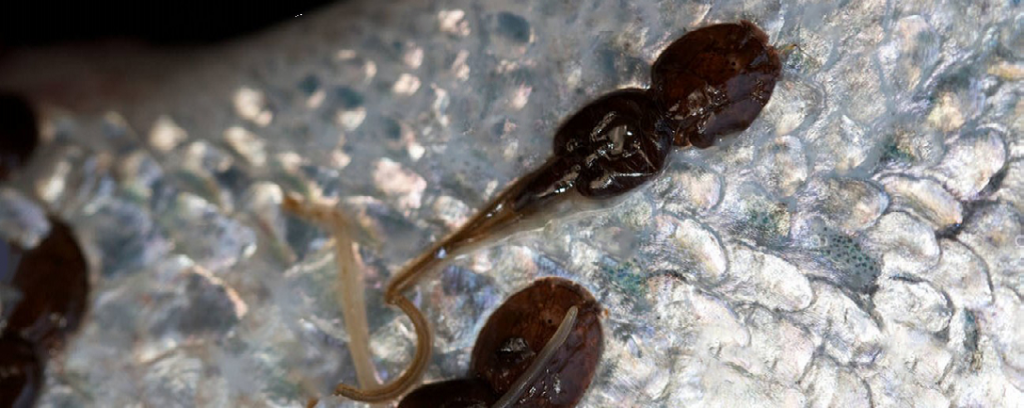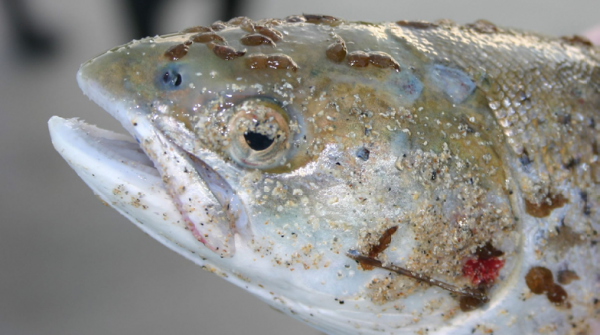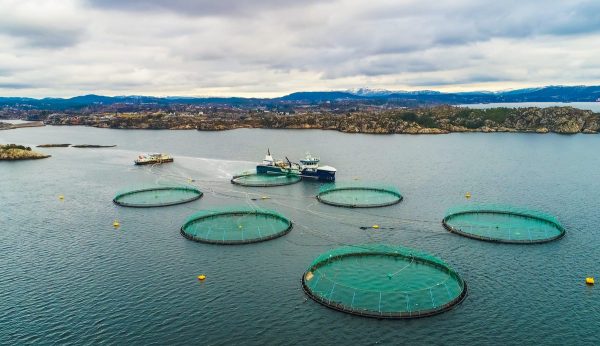Sea Lice
Sea Lice Inspection Ireland
In relation to sea lice, the Monitoring Protocol No. 3 for Offshore Finfish Farms, lays down specific protocols in relation to their monitoring. Sea Lice inspections are carried out by the Marine Institute on 14 occasions annually. Two inspections are carried out per month for March, April and May and monthly inspections outside this period. Only one inspection is carried out during the December / January period due to weather constraints.
The protocol lays down treatment trigger levels for sea lice within the period of March to May, which is referred to as the critical period. This period is consistent with wild salmon and sea trout outward migration. This "critical period" is reflected in lower trigger levels for mandatory treatment at 0.5 ovigerous (egg bearing) lice per farmed fish but certain licences indicate a lower level of 0.3 ovigerous lice per fish. The trigger level is also initiated if mobile lice infestation is high even in the absence of ovigerous lice.The lice treatment levels can be relaxed during harvest or by agreement with DAFM. The treatment level is set at 2 ovigerous lice per fish outside the spring period.
Is the sea lice inspection regime robust?
While there are 14 physical inspections carried out each year by the Marine Institute regarding sea lice levels, no account has been taken of the effect of biomass or numbers of salmon on the individual farms and thus the treatment trigger levels are somewhat redundant. For example, a farm with 250,000 fish has the same ovigerous lice treatment level per fish as a farm with 500,000 fish.
The very nature of the inspection regime is not robust enough with a very small number of 60 farmed fish being inspected per farm from two net pens, one standard pen and one random choice. With large farms consisting of up to close on a million fish it is highly unlikely that a sample of such order would satisfy any statistical model.
The size of farms and changing environmental factors must be taken into account and effectively a larger farm has more capability in production and distribution of excessive lice larvae in the wider environment. As such, today we are looking at a situation which is quite different to the previous generation of salmon farms which operated in different environmental and oceanic conditions and with a smaller biomass generally.
With warming sea temperatures there is also the specter of increased production of larval lice through reduced generation time and increased numbers of larval lice surviving which effectively increases the period and range away from a farm that they can remain infective to wild salmonids.
Sea Lice Species - Ireland
In regard to the sea lice issue there are two species of lice which are important to look at in regard to transfer from farm sources to wild salmon and sea trout. Lepeophtheirus salmonis (salmon lice) are host-specific to salmonid species while Calligus elongates (sea lice) can infest a large number of marine species but also affect wild salmon and sea trout.
Both species have a broadly similar life cycle but Calligus elongates can jump host thus providing an increased threat to infestation of farmed salmon from marine fish. This factor can have a knock on effect to wild salmon and sea trout through increased opportunity of larval distribution.
In general, given Ireland’s relatively mild sea temperatures, both sea lice species, after hatching on a farmed fish, have a finite period to infect wild fish. However, the number of larval lice released is extremely large as each ovigerous female may release many thousands of eggs over their life span.
Sea Lice Distribution - Far and Wide
During the first number of days post hatching, sea lice are non-feeding and passively drift within the top layer of the water column. Two stages of development are involved before transitioning to a third stage (copepod) where they become infective to wild salmon and sea trout.
As copepods they are more active swimmers and are positively phototactic (move towards light) allowing a louse to position itself in the water column in order to give itself the best opportunity of encountering a wild salmonid. The modeling process used by fish farming companies to demonstrate that lice from their farms do not reach estuaries are fatally flawed as no account of swimming potential is included in the process.
The first three planktonic stages of its life cycle can last up to a number of weeks so they can, in areas of strong currents and open coastline, be effectively transported to areas of the ocean which may be up to a 30 - 40 km from the original source. It is true that the density of the sea lice plume may weaken as they are distributed along the oceanic currents but it is also obvious that natural limits are vastly surpassed in proximity to farms and to some distance from these facilities.The sheltered farms within bays may also contain the larvae in a small geographic area which would compound the situation and effectively allow larvae be dispersed on an on-going basis with each tidal event.
Sea Lice Damage - A Question of Numbers
On successful contact with a host the lice go through a process of another number of stages of development during which the damage to the wild host can be devastating if enough individuals infest the fish. Of course sea lice are a natural parasite but the difficulty arises when their larval numbers are increased by the presence of a large number of hosts on a fish farm with opportunity to develop large overall numbers of ovigerous (egg bearing) female lice.
Large and uncontrollable destruction of wild salmon and sea trout
Salmon Farms - A Question of Scale
If we just think about it, there are upwards of close to a million adult salmon on some individual Irish farms which dwarfs the entire annual wild salmon returns to Ireland by a magnitude of 4:1. Effectively in one bay it is possible to have a situation where available hosts for sea lice infestation could run into the millions.
The practice and logic of treating the farmed fish is to limit the transition from attachment to maturity of the sea lice but this is more to do with protection of the livestock rather than the protection of wild salmonids.
New biological sea lice treatments rather than chemical treatments have been in operation in Ireland over the last number of years but these cleaner fish (wrasse and lump fish, which graze on sea lice attached to salmon) are becoming more susceptible to disease with a consequent knock-on effect on control of sea lice on farms. There are also growing concerns about the sustainability of (slow growing, late maturing) wild wrasse being captured to act as cleaner fish. This practice may lead to a cascade of effects as yet undetermined.

The sheer size of salmon farms allows the vast and uncontrollable spread of sea lice to the ocean environment.
Damage Sea Lice- Wild Salmonids
The sea lice which infest wild sea trout and salmon in aquaculture areas cause damage through physical injury which gives rise to physiological changes including elevated plasma cortisol, glucose and reduced osmo-regulatory function. All these negative effects may result in death of wild juveniles and indeed adults and it has also been observed that reduced growth, reduced reproduction and impaired swimming ability (increased predation risk) are consequences for wild fish in aquaculture areas, which lead to negative effects at a population level.
Sea Lice - Cause Alarming Decline in Irish Rivers
This results in a reduction in survival which for Atlantic salmon could be up to a 50% decline in returning adults in a year where a large biomass of salmon exists on an adjacent farm. For sea trout this reduction could be up to 90%. Both these percentage reductions are from research in the Erriff River (County Mayo) carried out over a long period by Inland Fisheries Ireland (IFI) and are probably similar to all west coastal areas where salmon farming is carried out.

Adult Atlantic Salmon returns may be down by up to 50% in Salmon farming areas. Source Inland Fisheries Ireland
The Marine Institute Viewpoint
Our own Marine Institute has stated that sea lice are a “minor and irregular” component in overall salmon survival. While agreeing that the effect is irregular this is as a consequence of environmental conditions being negative in certain years for lice larval survival and productivity, through reduced salinity in bays after high rainfall (newly hatched larvae do not survive below salinities of 15‰ and poor development of the infectivecopepodid occurs between 20‰ and 25‰) or low biomass of salmon on farms (generally in the first year of production when farmed post-smolts are on the farm).
An anecdotal point here would suggest that recent spring weather patterns in Ireland have been very dry during the April to June period giving excellent survival conditions for the larval stages of sea lice.
A Question of Interpretation - Sea Lice and Wild Salmonids
We certainly cannot agree that the effects are “minor” as the Marine Institutes own research indicates a loss of up to 20% of adult returnees. The confusion here relates to the Marine Institutes insistence that if 5% of salmon survive to come back as adults in aquaculture areas and 6% return in non-aquaculture areas there is only a 1% difference in overall survival.
This is in fact a large reduction in returning adults. If 100,000 smolts were to go to sea from rivers in a fish farming bay with high biomass, 5000 adults may return whereas a bay with no aquaculture would see 6000 fish return, a difference of 1000 fish, which is hardly minor in effect.
In relation to sea trout this would in all probability be much more damaging with very few surviving due to their reliance of near shore environments (where the farms are). The research carried out by international bodies and indeed Inland Fisheries Ireland (IFI) is broadly in line with the results and data of the Marine Institute but it is the interpretation of these results by the Marine Institute which is at odds with the vast majority of scientists both nationally and internationally.
Increased Biomass - Deenish Island
One instance which may illustrate an effect due to increased biomass is Kenmare Bay. An amendment to the Deenish Island licence had effectively doubled the amount of fish being stocked at this location with disastrous results for the sea trout populations of Waterville and other catchments within Kenmare Bay and Ballinskelligs Bay in Kerry.
Sea lice levels on individual farm fish were generally reported as low at the Deenish site yet premature returning sea trout were evident with a progressive collapse of rod catches of sea trout since 2011. The downward trend in Waterville has continued since, with an alarming collapse of the spawning stock and virtual disappearance of the larger sea trout for which the catchment was internationally famous. The increased biomass was only sanctioned on a pilot basis but the owners of the site continued to overstock the farm long after the pilot licence period expired.
Accordingly on the 17th April 2019 the Minister for Agriculture, Fisheries and Food withdrew the statutory entitlement of Silver King Seafoods Ltd. (a wholly owned Company of Comhlucht Iascaireachta Fanad Teoranta (MOWI Ireland) to continue aquaculture operations under the provisions of Section 19(A)4 of the 1997 Fisheries (Amendment) Act. Please find link to decision here : Ministerial Decision
Climate Change - More Escapes
The establishment of larger farms coupled with the ominous trend of increased severe weather patterns primarily involving more intense and destructive storms, increased escapement of salmon from farms is now a reality, with large numbers of farmed salmon turning up in wild salmon rivers in the west of Ireland in 2017. Other factors which also influence escapement involve the increased usage of well boats to treat fish for disease and parasites. Poignantly, the escaped salmon may spawn with wild fish causing a progressive dilution of wild genetics which could effectively destroy the productivity of wild systems.
The following video illustrates a number of techniques how lice are controlled by the industry. It must be strongly noted that wild salmonids do not appear to be a concern of the industry and effectively reductions in lice numbers are to protect the livestock on the farm. The current widespread use of pesticides are not mentioned also in order to "green" their image.



